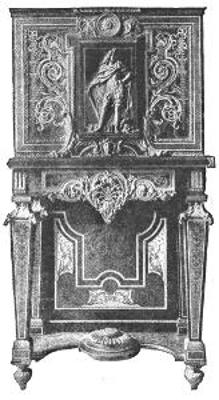The Mentor, No. 30, Furniture and its Makers
The Mentor
“A Wise and Faithful Guide and Friend”
Vol. 1 No. 30
FURNITURE AND ITS MAKERS
CHARLES ANDRÉ BOULLE
DANIEL MAROT
J. HENRI RIESENER
THOMAS CHIPPENDALE
THOMAS SHERATON
GEORGE HEPPELWHITE

By PROFESSOR C. R. RICHARDS
Director of Cooper Union, New York.
It is rather surprising to find how late a development furniture isin the modern sense. Up to the seventeenth century chairs werefar from common. Outside of the large and heavy armchairs reservedfor the head of the family, benches, chests, and stools were theonly seats in all but the wealthiest households. Before the sixteenthcentury fixed tables were unusual. Dining tables were almost alwayscomposed of a set of boards placed upon trestles at mealtime. Going alittle further back to the fourteenth century we find furniture, even incastles of the nobility, of the scantiest and simplest. In the sleepingrooms the pieces were limited to a bed, one or two chests, a bench beforethe fireplace, and seats built into the wall, commonly under the windows.In the hall where meals were served the only indispensable article besidesthe trestle tables and benches was a dressoir or buffet for the display ofplate. All of these pieces were exceedingly heavy and massive, and oftentimesbuilt into the structure of the room. Notuntil the seventeenth century did furniture becomelighter, more easily movable, and morecomfortable. It was at this period that chairs beganto be made with sloping backs and furnishedwith cushioned seats of leather or woven stuff.

LOUIS XIV CABINET
EXAMPLE OF BOULLE
Every age has impressed its artistic standardsstrongly upon the furniture of the period.Long after Gothic cathedral building had ceased,the cabinetmakers of northern Europe continuedto carve their delicate window traceryupon the panels of chests and buffets and tocopy the moldings of pier and mullion.

FRENCH OR FLEMISH CABINET OFTHE FIFTEENTH CENTURY
The Renaissance brought a great changein the surface appearance of furniture, and inItaly, France, Flanders, and Germany the newart spirit manifested itself in different forms,each of which reflected the peculiar genius of thepeople of the land.
But all the earlier developments in furniturewere overshadowedby the splendid achievementsof French art in the latter partof the seventeenth century. These beganunder Louis XIV, and continued withundiminished productiveness and refinementof design through the reigns ofLouis XV and Louis XVI, to a declineunder the Empire.
LOUIS XV—FURNITURE OFTHE BOUDOIR
The foundation by Colbert, ministerof Louis XIV, of the